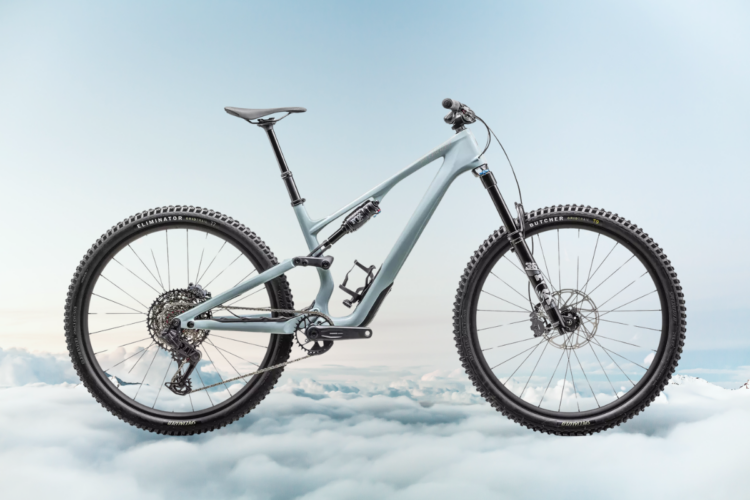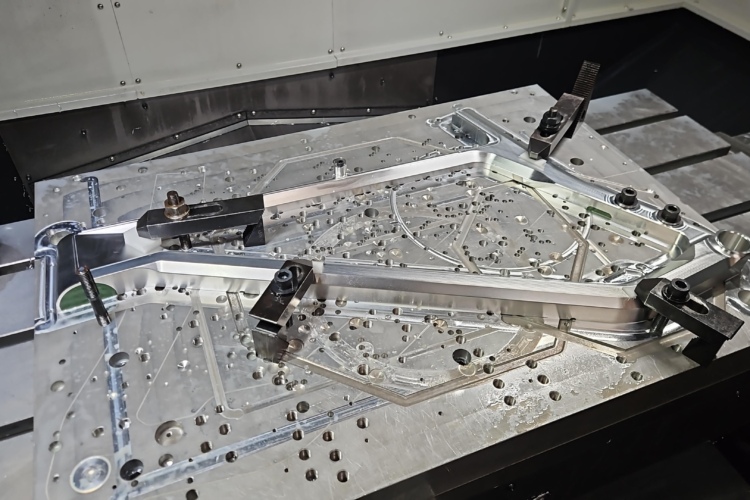I introduced you to the unique Slingshot Ripper 29er a few weeks ago here. I’ve been riding pretty much exclusively on the Ripper since then, including racing it at the Snake Creek Gap Time Trial. Now I’m ready to post my final review.
Geometry
I liked the geometry of the frame. The rear end is relatively short, the seat tube angle let me get the saddle where it needs to be, and the steering is very neutral. I’ve ridden both faster and slower handling bikes, but this one meets a nice middle ground between stable and fast handling. It handles tight twisty sections of trail and switchbacks with ease, while staying stable at speed.Putting a suspension fork on it would slacken the headtube a little and add even more stability.
The stable handling and compliant (for a rigid bike) ride were greatly appreciated while spending over 5 hours on the bike at the Snake. Photo: Featherbrush Photography
Stiffness
My major concern with the Sling Power system (more on that in a minute) was unwanted flex in the frame. I was mainly concerned there would be a lot of twist at the headtube. There is some, but not nearly as much as I would have suspected. The twist up front was mostly noticeable when making fast, hard, panic type steering inputs, like avoiding a tree at just the last second. You could feel the bars move, but it took longer than normal for the rest of the frame to follow suit, which can be a scary feeling when trying to avoid something on the trail. There’s a lot of twist when standing and climbing too, but to be honest I never really noticed this until I put a camera on the bike.
There is also a little lateral flex at the bottom bracket. Standing and climbing the frame would flex just enough to cause the chain to rub the front derailleur in certain gear combinations. The combination of bottom bracket flex and headtube twist could also be felt when stuffing the bike into berms, where you can carry a lot of speed through a relatively sharp turn. It sort of “sponges” into the corner, if that makes any sense. Probably not, but I don’t know how else to explain it. It was only noticeable when really railing a berm, and it didn’t slow me down any, just a strange feeling.
Ted did some ‘durability’ testing and wadded it up at speed once on the Slingshot. He broke a rib, but the bike was fine. Photo: TedS
Ride Quality
One of the buzz phrases often used in bike reviews is ‘vertical compliance’, which basically means the frame has a little up and down flex to add some comfort to the ride. Well, the Ripper really does have vertical compliance thanks to the Sling Power system. The cable/spring/flexboard allow the front end of the bike to move up and down a good bit, and the bike is the most comfortable rigid bike I’ve ever ridden thanks to that. For sure you still feel the big hits, but I found myself staying seated through smaller rumbling bumpswhere I would have stood while riding my rigid steel bike.
It’s A Looker
This bike is different, and it draws a lot of attention. Every time I took it out I got lot of questions and comments. What is it? Why? What’s it supposed to do? Does it work? And my favorite – “Dude! You’re missing part of your frame!” It’s a heck of a conversation starter. It’s even fun to watch people sitting behind me at redlights when the bike is on the rack; they look puzzled and confused. You might meet the nicest people on a Honda, but you meet a whole lot more people on a Slingshot!
Sling Power: Does It Work?
“Does it work?” That’s the question I always get after explaining the Sling Power system to people. To be honest, I can’t really say one way or the other. The engineer in me knows the cable cannot only pull the real wheel forward, it’s also pulling the front wheel backwards. That whole “for every force there is an equal and oppositeforce” thing. And, for it to store energy to use during the dead portion of the pedal stroke it has to rob some energy during the active portion of the pedal stroke. But, it climbs surprisingly well, especially for the weight. And it is heavy, easily over a pound heavier than some traditional steel hardtail frames, and even more than an aluminum frame. Yet, it seems to almost hold momentum when climbing, kind of like the same sensation you get on flat terrain afterswitching to faster rolling tires.
I raced the Ripper at round 2 of the Snake, a very tough techincal course, and turned in my fastest time of the three race series that day. Photo: Joe Cattoni
I mounted a camera on the seat tube, just below the flexboard, and went for a quick spin around the neighborhood to get a view of the spring and cable while riding. I discovered there is no real movement when climbing in the saddle. For the system to work (even in theory) the cable must compress the spring under pedal input and re-extend during the dead portion of the pedal stroke, and while seated, I don’t see that happening. However, as soon as I stood up and pedalled, it went to work, and you can see the spring compressing and extending a lot. You can also see the head tube twisting a good bit as I mentioned above. But, does it make me faster going up hill? I don’t know. It certainly doesn’t slow me down, but I can’t say for certain that it makes me faster. It doesn’t increase your power output, it just smooths it out so it’s more consistent. I let my friend Ted borrow the bike for a few days and he had a similar conclusion. Can’t say for certain it makes you faster, but it climbs surprising well.
What to look for in the video: watch the spring do it’s thing when I stand. You can also see the headtube twisting. When I take the right hand turn there’s a bit of twist, but you can also see the system absorb a bump mid-corner. (I waswearing a jacket unzipped, not a cape)
If this were Mythbusters, I’d have to give the Power Sling a ‘Plausible” rating.
Maintenance and Other Considerations
Another frequent question I heard while testing the Ripper was what sort of maintenance is required for the Sling Power system. I asked Slingshot about it, and here’s their response:
The Dogbone will not be affected by summer heat or winter’s cold. It will not absorb water and none of the typical cleaners/solvents have any affect. (DOT 3 brake fluid should be given the same care/attention as any other part of the bike frame). Most riders put 6-7+ seasons of hard core riding on the Dogbone. It will show signs of replacement: the bike might feel “sloppy,” the exposed surface may show signs of age/cracks/separation. In a neutral environment it has an indefinite lifespan, if the bike was ridden hard for 3 years then put in storage for 15 years treat it like it’s 3 years old.
There are so many variables to factor with replacement it’s hard to say. In all the years of using the Crossply material (29 yrs.) we have never had a failure! The actual “Dogbone style” has been in use since 2005 with more than 95% of the bikes still using the original piece. Currently replacement cost is $100 and the customer can do so themselves. It will also be be available for years and years to come with the price remaining about the same or even less.
There are a few other considerations due to the Sling Power system. As you’re well aware, the Ripper doesn’t have a downtube which means there’s only one bottle mount on the seat tube. Also, if your rack grabs the downtube, well, there isn’t one on this bike.
Without a downtube for the stabilizing arm of his roof rack to hold onto, Ted had to improvise. Do not try this at home kids. Photo: TedS
Final Verdict
Full disclosure: going into this review I expected the Ripper to suck. It doesn’t! It’s a fun bike to ride, the geometry is a good compromise of stable and agile. The Sling Power system leads to fairly comfy ride, and the bike climbs way better than the weight would lead you to believe. Still, it’s not perfect and nothing is. It’s heavy, and there’s some un-nerving flex felt occassionally. But all in all, it’s a fun ride. So if you’re looking for a new bike, and want something unique from a smaller manufacturer, check out the Ripper 29er. You can get just a frame, or they can build you a complete bike with whatever spec you want. Check out the Slingshot website for full details.
Special thanks to Slingshot for providing the bike for testing.















7 Comments
Mar 12, 2012
Mar 14, 2012
Mar 12, 2012
Mar 14, 2012
Another good review and I hope Ted's ribs heal soon.
Mar 16, 2012
Mar 12, 2012
Mar 13, 2012
On the video, I can see the frame moving relative to the camera on the top tube due to the camera not being attached 100% securely. This motion will be multiplied by the distance to the head tube so I suggest that although there is some head tube twist (and I respect your educated opinion having actually ridden the thing!), there might not actually be as much as you first though.
You did say you didn't notice it when riding, only on the video after all!